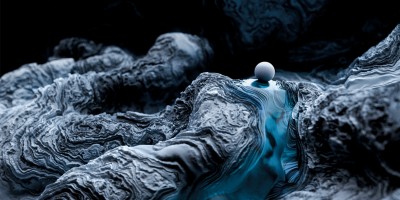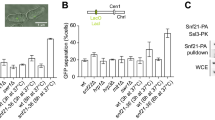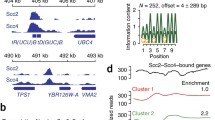Abstract
Fission yeast centromeres, like those of higher eukaryotes, are composed of repeated DNA structures and associated heterochromatin protein complexes, that have a critical function in the faithful segregation of chromosomes during cell division1,2,3. Cohesin protein complexes, which are essential for sister-chromatid cohesion and proper chromosome segregation, are enriched at centromeric repeats4,5. We have identified a functional and physical link between heterochromatin and cohesin. We find that the preferential localization of cohesins at the centromeric repeats is dependent on Swi6, a conserved heterochromatin protein that is required for proper kinetochore function. Cohesin is also enriched at the mating-type heterochromatic region in a manner that depends on Swi6 and is required to preserve the genomic integrity of this locus. We provide evidence that a cohesin subunit Psc3 interacts with Swi6 and its mouse homologue HP1. These data define a conserved function of Swi6/HP1 in recruitment of cohesin to heterochromatic regions, promoting the proper segregation of chromosomes.




Similar content being viewed by others
References
Takahashi, K. et al. Mol. Biol. Cell 3, 819–835 (1992).
Ekwall, K. et al. Science 269, 1429–1431 (1995).
Partridge, J. F., Borgstrom, B. & Allshire, R. C. Genes Dev. 14, 783–791 (2000).
Tomonaga, T. et al. Genes Dev. 14, 2757–2770 (2000).
Watanabe, Y., Yokobayashi, S., Yamamoto, M. & Nurse, P. Nature 409, 359–363 (2001).
Blat, Y. & Kleckner, N. Cell 98, 249–259 (1999).
Megee, P. C., Mistrot, C., Guacci, V. & Koshland, D. Mol. Cell 4, 445–450 (1999).
Tanaka, T., Fuchs, J., Loidl, J. & Nasmyth, K. Nature Cell Biol. 2, 492–499 (2000).
Tanaka, T., Cosma, M. P., Wirth, K. & Nasmyth, K. Cell 98, 847–858 (1999).
Nakayama, J., Klar, A. J. & Grewal, S. I. Cell 101, 307–317 (2000).
Allshire, R. C., Nimmo, E. R., Ekwall, K., Javerzat, J. P. & Cranston, G. Genes Dev. 9, 218–233 (1995).
Miyazaki, W. Y. & Orr-Weaver, T. L. Annu. Rev. Genet. 28, 167–168 (1994).
Murphy, T. D. & Karpen, G. H. Cell 82, 599–609 (1995).
Nakayama, J., Rice, J. C., Strahl, B. D., Allis, C. D. & Grewal, S. I. Science 292, 110–113 (2001).
Lachner, M., O'Carroll, D., Rea, S., Mechtler, K. & Jenuwein, T. Nature 410, 116–120 (2001).
Bannister, A. J. et al. Nature 410, 120–124 (2001).
Niwa, O., Matsumoto, T., Chikashige, Y. & Yanagida, M. EMBO J. 8, 3045–3052 (1989).
Tatebayashi, K., Kato, J. & Ikeda, H. Genetics 148, 49–57 (1998).
Saitoh, S., Takahashi, K. & Yanagida, M. Cell 90, 131–143 (1997).
Beach, D. H. & Klar, A. J. EMBO J. 3, 603–610 (1984).
Wang, G. et al. Mol. Cell. Biol. 20, 6970–6983 (2000).
Gonzalez, C., Casal Jimenez, J., Ripoll, P. & Sunkel, C. E. Exp. Cell Res. 192, 10–15 (1991).
Hoque, M. T. & Ishikawa, F. J. Biol. Chem. 276, 5059–5067 (2001).
Hauf, S., Waizenegger, I. C. & Peters, J. M. Science 293, 1320–1323 (2001).
Bähler, J. et al. Yeast 14, 943–951 (1998).
Watanabe, Y. & Nurse, P. Nature 400, 461–464 (1999).
Shinozaki-Yabana, S., Watanabe, Y. & Yamamoto, M. Mol. Cell. Biol. 20, 1234–1242 (2000).
Durfee, T. et al. Genes Dev. 7, 555–569 (1993).
Acknowledgements
We thank J. P. Cooper, K. Tatebayashi, R. C. Allshire, O. Niwa and M. Yanagida for providing strains and plasmids, and P. Nurse, J. P. Cooper, A. W. Murray and K. Nasmyth for valuable discussion. Y.W. thanks all the members of M. Yamamoto's laboratory for their support. This work was supported in part by grants from the Ministry of Education, Science, and Culture of Japan, and NIH grant 59772.
Author information
Authors and Affiliations
Corresponding author
Supplementary information
Supplementary information
The effect of psc3 and swi6 mutations on silencing of ura4+ inserted at the mating-type region or cen1. (PDF 995 kb)
Rights and permissions
About this article
Cite this article
Nonaka, N., Kitajima, T., Yokobayashi, S. et al. Recruitment of cohesin to heterochromatic regions by Swi6/HP1 in fission yeast. Nat Cell Biol 4, 89–93 (2002). https://doi.org/10.1038/ncb739
Received:
Revised:
Accepted:
Published:
Issue Date:
DOI: https://doi.org/10.1038/ncb739
- Springer Nature Limited
This article is cited by
-
Dicer promotes genome stability via the bromodomain transcriptional co-activator BRD4
Nature Communications (2022)
-
Centromeres are dismantled by foundational meiotic proteins Spo11 and Rec8
Nature (2021)
-
Conserved chromosomal functions of RNA interference
Nature Reviews Genetics (2020)
-
Genetic and epigenetic effects on centromere establishment
Chromosoma (2020)
-
Rpd3L and Hda1 histone deacetylases facilitate repair of broken forks by promoting sister chromatid cohesion
Nature Communications (2019)





